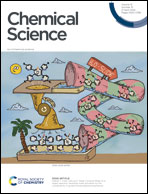Shape memory and self-healing in a molecular crystal with inverse temperature symmetry breaking†
Abstract
Mechanically responsive molecular crystals have attracted increasing attention for their potential as actuators, sensors, and switches. However, their inherent structural rigidity usually makes them vulnerable to external stimuli, limiting their usage in many applications. Here, we present the mechanically compliant single crystals of penciclovir, a first-line antiviral drug, achieved through an unconventional ferroelastic transformation with inverse temperature symmetry breaking. These crystals display a diverse set of self-restorative behaviors well above room temperature (385 K), including ferroelasticity, superelasticity, and shape memory effects, suggesting their promising applications in high-temperature settings. Crystallographic analysis reveals that cooperative molecular displacement within the layered crystal structure is responsible for these unique properties. Most importantly, these ferroelastic crystals manifest a polymer-like self-healing behavior even after severe cracking induced by thermal or mechanical stresses. These findings suggest the potential for similar memory and restorative effects in other molecular crystals featuring layered structures and provide valuable insights for leveraging organic molecules in the development of high-performance, ultra-flexible molecular crystalline materials with promising applications.



 Please wait while we load your content...
Please wait while we load your content...